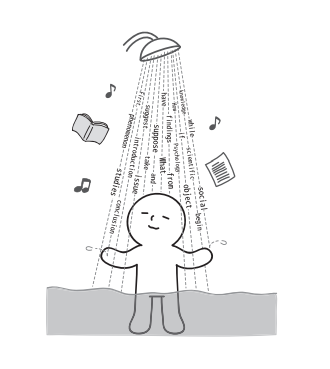Difference between revisions of "Language Shower/OG"
Jump to navigation
Jump to search
Submerge yourself in the environment where you inevitably have exposure to the language you want to master.
***
▼In this context
▼Therefore
Sfrancisco (talk | contribs) (Added category) |
Sfrancisco (talk | contribs) (Added category) |
||
| Line 5: | Line 5: | ||
|image= <!-- Provide the filename of the image to be displayed (e.g., Design_pattern.png) --> | |image= <!-- Provide the filename of the image to be displayed (e.g., Design_pattern.png) --> | ||
|contributor= [[Takashi Iba]], [[Mami Sakamoto]] | |contributor= [[Takashi Iba]], [[Mami Sakamoto]] | ||
|source= Iba & Sakamoto (2011)<ref name="Iba">Iba, T., & Sakamoto, M. (2011). [http://dl.acm.org/citation.cfm?id=2579166 Learning patterns III: a pattern language for creative learning.] In ''Proceedings of the 18th Conference on Pattern Languages of Programs'' (p. 29). ACM.</ref>; Iba (2010)<ref name="Iba2010">Patlet mentioned in Iba, T. (2010). [https://pdfs.semanticscholar.org/6e59/51c886e73a6efdc88f7be185d2f9336025ef.pdf Designing a Pattern Language for Creative Learners].</ref>; Köppe & Nijsten (2012)<ref name="Koppe">Also mentioned in Köppe, C., & Nijsten, M. (2012). [http://www.hillside.net/plop/2012/papers/Group%201%20-%20Elk/A%20Pattern%20Language%20for%20Teaching%20in%20a%20Foreign%20Language%20-.pdf A pattern language for teaching in a foreign language: part 2]. In ''Proceedings of the 19th Conference on Pattern Languages of Programs | |source= Iba & Sakamoto (2011)<ref name="Iba">Iba, T., & Sakamoto, M. (2011). [http://dl.acm.org/citation.cfm?id=2579166 Learning patterns III: a pattern language for creative learning.] In ''Proceedings of the 18th Conference on Pattern Languages of Programs (PLoP 2011)'' (p. 29). New York:ACM.</ref>; Iba (2010)<ref name="Iba2010">Patlet mentioned in Iba, T. (2010). [https://pdfs.semanticscholar.org/6e59/51c886e73a6efdc88f7be185d2f9336025ef.pdf Designing a Pattern Language for Creative Learners].</ref>; Köppe & Nijsten (2012)<ref name="Koppe">Also mentioned in Köppe, C., & Nijsten, M. (2012). [http://www.hillside.net/plop/2012/papers/Group%201%20-%20Elk/A%20Pattern%20Language%20for%20Teaching%20in%20a%20Foreign%20Language%20-.pdf A pattern language for teaching in a foreign language: part 2]. In ''Proceedings of the 19th Conference on Pattern Languages of Programs (PLoP 2012)'' . New York:ACM.</ref> | ||
|dataanalysis= <!-- If applicable, list of data analyses used for mining the pattern separated by a " , "comma --> | |dataanalysis= <!-- If applicable, list of data analyses used for mining the pattern separated by a " , "comma --> | ||
|domain= <!-- Learning domain the design pattern belongs to (e.g., General, Math, Algebra) --> | |domain= <!-- Learning domain the design pattern belongs to (e.g., General, Math, Algebra) --> | ||
| Line 52: | Line 52: | ||
<references/> | <references/> | ||
[[Category:Design_patterns]] [[Category:Full_Pattern]]<!-- List of other categories the design pattern belongs to. The syntax for linking to a category is: [[Category:<Name of category]] --> | [[Category:Design_patterns]] [[Category:Full_Pattern]] [[Category:Creative Education Patterns]] [[Category:Traditional Classroom]]<!-- List of other categories the design pattern belongs to. The syntax for linking to a category is: [[Category:<Name of category]] --> | ||
Latest revision as of 07:04, 16 May 2017
| Language Shower | |
| Contributors | Takashi Iba, Mami Sakamoto |
|---|---|
| Last modification | May 16, 2017 |
| Source | Iba & Sakamoto (2011)[1]; Iba (2010)[2]; Köppe & Nijsten (2012)[3] |
| Pattern formats | OPR Alexandrian |
| Usability | |
| Learning domain | |
| Stakeholders | |
Also Known As: Shower of Language (Shower of Language)[2]
“There is no way to stop sound and have sound.” — Walter J. Ong
You want to be good at listening and reading in a language.
To master languages is tough.
- • The sense of a language is much affected by the nature and culture where it is used.
- • The stock of expressions enables you to convey what you want to say.
- • It takes a long time to master a language.
Set up your environment where you always listen and read in the target language.
- • If you want to master a foreign language, set up your environment, for example, using mobile media, and to continue listening to and reading it.
- • Then, make rules to use the language every day, for example, just listen to an online radio broadcast or audio book in the background. Making a physical record of your learning activities as Tangible Piles (Tangible Piles) is a good way to maintain your motivation.
References
- ↑ Iba, T., & Sakamoto, M. (2011). Learning patterns III: a pattern language for creative learning. In Proceedings of the 18th Conference on Pattern Languages of Programs (PLoP 2011) (p. 29). New York:ACM.
- ↑ 2.0 2.1 Patlet mentioned in Iba, T. (2010). Designing a Pattern Language for Creative Learners.
- ↑ Also mentioned in Köppe, C., & Nijsten, M. (2012). A pattern language for teaching in a foreign language: part 2. In Proceedings of the 19th Conference on Pattern Languages of Programs (PLoP 2012) . New York:ACM.
